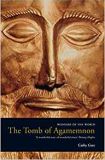The Tomb of Agamemnon by Cathy Gere
| The Tomb of Agamemnon by Cathy Gere | |
|
| |
| Category: History | |
| Reviewer: Magda Healey | |
| Summary: The real, the mythical and the cultural history of Mycenae: the fabled, golden, bloody city of the Atreides, told in a sparkling prose, accessible but never looking down to the reader, and showing how we tell and retell old myths and new discoveries depending on current zeitgeists. Highly recommended. | |
| Buy? Yes | Borrow? Yes |
| Pages: 208 | Date: April 2007 |
| Publisher: Profile Books Ltd | |
| ISBN: 978-1861976673 | |
|
| |
The grim and heroic myth of the Mycenaean Atreides has had a hold on European imagination for thousands of years now: from Homer and the tragedians of the Classical Greece to the Eastern Question so hot in 19th century to the Freudian psychoanalytical myth-making and the modern feminist tale of gentle matriarchate. People have been gazing into the past, seeing their own reflection in the dark tale of Agamemnon, his ancestors and children.
When Heinrich Schliemann, a maverick archaeologist, a Homer literalist and a self-aggrandising myth-maker himself, dug out corpses covered in gold from the ancient graves at Mycenae and announced them to be the graves of Agamemnon and his peers, the myth was revealed as reality and the hold of Mycenae on the cultural imagination increased a hundred-fold. Everybody had a use for the mask of Agamemnon even though Schliemann's interpretation was soon shown to be completely incorrect. Since then, a gulf had been growing between the archaeologists' knowledge of Mycenaean Bronze Age civilisation and the pilgrimages of the public (and the modern myth-makers) in search of a non-existing tomb of a legendary warlord.
The series of books published in the Profile Books' Wonders of the World series tend to chronicle the posthumous life of sites and artefacts which have achieved an iconic status in our culture. They also often show that interpretations of those icons tell as much - or more - about the interpreters as about the people who originally created them: about how we take an object, a place, a character and retell it constantly, and then tell and retell the story of retellings too.
Cathy Gere's book concerns itself with the mythical tomb of Agamemnon as much as with the very real site of the citadel at Mycenae. She acknowledges that there is more to Mycenae than the dry kernel of certainty that can be gleaned from the analysis of pottery: the truth must include the layer upon layer of myth that it attracted since its downfall. She starts her tale when the myth seems to have started: in the cult of heroes common in Greece 400 years after the citadel fell, in the era that gave us Homer's epics and then continues to the frenzy following Schliemann's discovery and beyond.
Gere makes an excellent job of exploring this tangle and presents a chronological account, alternating and contrasting the story of the archaeological discovery with the account of the astonishing cultural career of the Bronze Age Mycenaeans and extravagant uses the hapless ghost of Agamemnon has been put to.
Both strands of the story are fascinating, and both are told with élan and passion. Gere writes a well flowing prose, light but not shallow, with the author's personal attitudes expressed in an occasional wry remark, not shying from a colloquialism or two (e.g. gold finds are gorgeous) and emotion. Erudite and illuminating, she makes the connections across vast areas of history without pontificating or getting bogged down in the antiquary detail: The Tomb of Agamemnon is never boring and manages to tell a lot in a small volume. The chronological order suits it well and makes it easier to deal with a lot of factual data provided, as well as being rather appropriate to the story about power of stories, referencing one of the most enduring narratives of European heritage.
As befits the king of warlords, the questions asked of Agamemnon concerned violence and the role of warfare in human society. Classical Greeks were born into the state of perpetual war, whose agony was tempered by the ritualised custom of the combat. The mythical Trojan campaign was seen as a precursor of the Persian wars, and both were utilised in the arguments surrounding the Eastern Question in the 19th century.
Agamemnon was thus reined into services of anti-Ottoman struggle of the Greek War of Independence, but more fascinatingly, into the creation of the supremacist ideologies of the Aryan race where occupants of Mycenae tombs were hailed as Teutonic (!) Aryan proto-Nazis whose war of extermination melted the walls of Middle-eastern Troy. Here, Gere doesn't shy from value judgements, but she doesn't fall foul of anachronistic sin of wholesale transplantation of 21st century sensibilities to that vanished time, when racial hierarchies of Aryan ideologies were a respectable part of the search for a scientific account of human origins, and when nationalism was still posed between idealism and atrocity. She uses rather passionate if ironic language when referring to D'Anuzzio, the first of the Nietzsche inebriated artists to reel away from the site of Schliemann's excavations in a fever of inspiration, but she brings our shared experience of the 20th century horrors to illuminate an entirely different state of mind 100 years ago when she describes Europe filled with neurasthenic young scholars, innocent of the horrors of combat, marshalling archaeological evidence in support of their dreams of blood and empire.
Can the political myth-making stop? Can we leave the ghosts of Atreides to lie while still continuing to explore the realities about these long-disappeared civilisations of 3,500 years ago? And can we ever stop to cut the finds and the old stories to size, guided by current topical issues of the time?
If you are interested in the history of thought, the anthropology of science or simply in how particular story has been told, interpreted and used over the centuries, The Tomb of Agamemnon is a great exploration of these subjects based on a truly iconic site & set of artefacts, well written, passionate and illuminating.
If you ever, even as a small child, dreamed about being Schliemann, Evans or Carter, if you liked the stories of discovering the ancient civilisations more then those civilisations' histories then Cathy Gere's book is a must. I loved it.
A big thank you for Profile Books for sending us this excellent book.
John Keegan's A History of Warfare explores the hows and whys of European warmaking and has a fascinating chapter devoted to the warfare of ancient Greeks.
You might like to read reviews of other books in Profile's Wonders of the World series: The Rosetta Stone by John Ray, St Pancras Station by Simon Bradley and Gavin Stamp's The Memorial to the Missing of the Somme.
Please share on: ![]() Facebook,
Facebook, ![]() Twitter and
Twitter and
![]() Instagram
Instagram
![]() You can read more book reviews or buy The Tomb of Agamemnon by Cathy Gere at Amazon.co.uk Amazon currently charges £2.99 for standard delivery for orders under £20, over which delivery is free.
You can read more book reviews or buy The Tomb of Agamemnon by Cathy Gere at Amazon.co.uk Amazon currently charges £2.99 for standard delivery for orders under £20, over which delivery is free.
![]() You can read more book reviews or buy The Tomb of Agamemnon by Cathy Gere at Amazon.com.
You can read more book reviews or buy The Tomb of Agamemnon by Cathy Gere at Amazon.com.
Comments
Like to comment on this review?
Just send us an email and we'll put the best up on the site.


